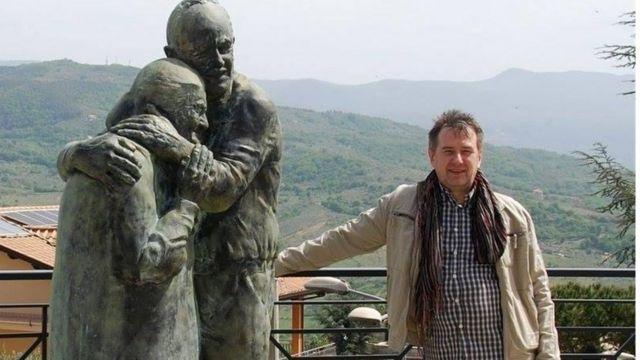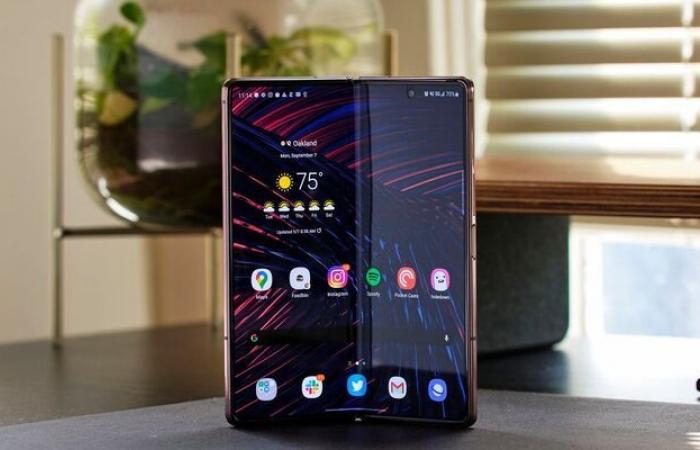Valentine's Day: Why do lovers swear in front of a statue of two old men embracing?
How can a reserved and shy Ukrainian villager and an Italian soldier captured in a Nazi prison imagine that their names will be transmitted by the media one day, and that a statue that brings them together in an embrace that has been waiting for decades will become a kiss for lovers?
It's love! It transcends time, and is stronger than circumstances, wars, and borders created by policies. Rather, it is not love alone, there is also hope that was like an impossible dream, and the determination of those whose heart does not grow old, at least on the part of a former Italian soldier who is nearly ninety years old.
In Mariinsky Park, in the heart of the Ukrainian capital, Kiev, near a small bridge called the "Lovers' Bridge", there is a bronze statue of two old men embracing, they are Mocrina and Luigi.
Her head is buried in his chest, and his arms surround her bent shoulders in a moment of containment, summarizing the longing of more than sixty years.
In front of this statue, which bears the signature of the well-known Ukrainian sculptor Alexander Murgatsky, today's lovers, whether residents or visitors of the city, exchange vows of love, and with it those celebrating their wedding day take souvenir photos, as the lonely ones come to it carrying their wishes, and it is not strange to leave On its base are roses for a loved one or a message carrying the hope of a meeting.
Skip topics that may interest you and continue reading. Topics that may interest youtopics that may interest you. End
So what tempts hearts with the blessings of these two old men?
"Mocrina and Luigi's love brought them together again despite war, political borders, age, and all obstacles," Andriy Miroshnichenko told BBC News Arabic, a writer and traveler from Kiev.
And he added, "The statue's proximity to the bridge on which the lovers hang the locks that symbolize their bond gives it an additional important symbolic dimension. Love is a bridge that connects two lovers, even if they are from two different worlds and cultures, just as this small bridge connects the two ends of the garden."
Love in Confinement
The time: 1943, the place: Sankt Pölten, a notorious forced labor camp in northeastern Austria.
At that time and place Luigi Peduto, a captured Italian non-commissioned officer, met Mukerina Yorzok, a young Ukrainian widow who was seven months pregnant, taken to the camp as a forced laborer, and there she gave birth to her child.
Luigi joined his country's army in December 1941, and he had spent about two years fighting on the Croatian front, when Italy signed an armistice with the coalition forces on September 3, stipulating its surrender to the allies who occupied the southern part of its territory .
In the same month, Luigi's battalion fell into German hands, and the captured soldiers were marched on foot to Budapest, Hungary. From there Luigi was sent to Sankt Pölten, which was the nearest forced labor camp, to which prisoners whose skills could be put to use in the German war effort.
In that terrible place, Mocrina was once asked to help a handsome young Italian mix cement to build new fortifications.
Skip the podcast and read onMorahakatyTeenage taboos, hosted by Karima Kawah and edited by Mais Baqi.
The episodes
The end of the podcast
Mocrina did not speak Italian, nor did Luigi speak Ukrainian, but they exchanged smiles, which soon widened into laughter despite the bleakness of the situation, and they felt closeness and comfort, and from then on the two became keen to work together whenever they could, according to what was reported by the "Facti" newspaper. e-commentary" Ukrainian on Mukhrina.
But the Italian prisoner had apparently already noticed the young woman, who was about twenty-three or twenty-four years old, and had attracted his attention.
When he learns that she has a baby girl, his sympathy is added to his admiration for her, and Luigi helps Mocrina, or Maria as he likes to call her, and gives her what he saves from his miserable meals. Soon, love became their third, and the light of the dark tunnel in which they lived.
Luigi, who mastered sewing, used to fix her clothes and make hats for Mocrina, and she, in turn, helped him as much as she could, and they understood in a language that was a mixture of a few words of Italian, Russian and Ukrainian, and often without words.
After two years during which they were together in detention, the war ended, and each of them was sent to his country, and neither he nor she was allowed to accompany the other.
Luigi has returned to his hometown of Castel San Lorenzo in the province of Salerno in southeastern Italy, and to his work in accounts and financial management.
Mocrina has returned to her small village, to work on a collective farm.

With the inability to communicate with his beloved, who became behind the Soviet Iron Curtain, Luigi later married, had children and had grandchildren, although he still kept a picture and a lock of his beloved's hair, who also got married and had more children and became a grandmother.
But after nearly six decades of separation, and two completely different life experiences, the two met again in 2004 after they "thought they would not meet", and it was a very touching emotional moment, in which tears mixed with smiles with tremors of the heart, and millions watched it directly on the program screen. My TV.
The Lover's Persistence
Mokarina did not forget her lover, and kept his image, but for her he turned into a beautiful, distant memory, suitable as a story to be told to the grandchildren, and she had no hope, but even a dream of meeting him.
But Luigi acted differently. He tried for a long time to find her, but to no avail, until he learned that there was a TV program called "Grandfather Minia", which means "Wait for Me", headquartered in Moscow and has a branch and local preparers in Kiev on Inter channel, and it is dedicated to reuniting people who have lost contact, And they were stranded.
Luigi wrote to the program's Moscow office, asking to find his old girlfriend, using the little information he knew about her.
Months passed, which he felt were longer than an eternity, before he received an invitation from the program as a guest to talk about his story and his long search for Mocrina.
But there, they told him that they had found his girlfriend, and you can imagine his reaction. Luigi knelt on the ground in disbelief. As for the biggest surprise, Mokarina herself entered the next moment, to suddenly find himself in front of his beloved, whom he lost track of years ago.
Time had worn them both, and Mocrina's rough life had left its mark on her.
But Luigi rushed to her to hug her very warmly, tears of joy welled up in his eyes, and he repeated, "Maria... oh... Maria, I'm Luigi... the Luigi you know"... .
As for Mocrina, who is shy and reserved by nature, she surrendered completely to his embrace with the confusion of a little girl, and with a lively smile. without saying a word.
This is the moment that the statue embodied.
Scenes speak louder than languages
When the sculptor Aleksandr Murgatsky sent me a videotape for a Ukrainian-language television program about the tale of the two lovers, their first meeting in a studio in Moscow, and what happened afterwards. I didn't really need Alexander's explanation, nor knowledge of the language.
The overwhelming emotions in that moment of embrace were more eloquent than all languages, as well as the scene of Luigi getting off the train and rushing as far as his years could handle him to meet Mocrina, who was waiting on the station platform on his first visit to her village, and then the two lovers walking hand in hand in Luigi's town, Or when they are gathered at a dining table with an extended family of children and grandchildren.
As well as the scene of Luigi singing in Italian while preparing pasta sauce, and the satisfied smile on Mocrina's face, which seemed to say, "Well.. what should I do with this lover who does not grow old?".
However, despite all the love, and both of them have been widowed for a long time, Mocrina rejected Luigi's insistent and repeated proposal of marriage. As her granddaughter said, Mokerena was unable to leave her village, or to change her life.
But the two continued to exchange visits as often as health permitted them, as well as gifts, especially Parmesan cheese, which Luigi was keen to send to Mocrina.
Meeting Khaled
In 2013, Alexandre received a request from Inter channel to make a statue of the most famous reunion stories that she contributed to, which is of course the story of Luigi and Mocrina.
"There is something unique about this story," Alexander told BBC News Arabic. "Something so personal, yet so touching, that it touched the hearts of hundreds of thousands, even millions of viewers. This put a huge responsibility on my shoulders."
He tells me that he did not get to meet the two heroes of the story before making the statue, but he watched all the TV programs about them, especially the moment of the first meeting, which he re-watched dozens of times.
And he adds, "It was an exceptional moment that deserves to be immortalized. Luigi's reaction amazed me and affected me a lot. His emotions were explosive. We in Ukraine are more conservative in expressing emotions."
It took Alexander, or Sasha, as everyone calls him, about two months to complete the statue, and his friend, sculptor Grigory Kostyukov, helped him in the work.
"Everything is destined to disappear, but love will remain."
The statue was unveiled on May 7, 2013 in Kiev. And Alexandre tells me that Mocrina was unwell to attend the celebration, and sent her granddaughter to act on her behalf.
As for Luigi, he would not have missed the occasion, and made the trip from Italy, despite his old age. Alexander says, "We became friends immediately. He was a wonderful person, and his impact was very clear on the statue, which preserved the most precious moment in his life, as he said. He expressed his great gratitude to me and Grisha (Gregory). In fact, the emotion was evident on the faces of everyone who attended the occasion."
And he adds, "Luigi was clearly tired, but he did not accept that we help him, or that he lean on any of us, repeating 'Isono Carabinieri' and I think it means I am a soldier."
And about his special feelings about this work, Alexander, who has many sculptures and works of art bearing his signature in other squares and gardens in Kiev and other cities, says, "It is a nice feeling that your work resonates with many people. It is nice that this statue reminds us of an amazing love story, but it A truly living story, one that derives its continuity from its strength and uniqueness.
In 2017, a completely identical copy was unveiled in Castel San Lorenzo, Luigi's town, but in the absence of the two protagonists of the story this time. Luigi died, as Alexander tells me, in 2013, about three months after the opening of the Kiev statue, while Mocrina, who was injured With amnesia, I caught him in 2015.
The two are gone, but their love story is still an inspiration and hope for lovers, and there is no doubt that the statue of their eternal embrace will witness these days with the advent of love, many kisses and roses.
In conclusion, Andrei Mirosnichenko says, "I am very happy that we have this statue here in Kiev. It is a reminder to us that everything is destined to disappear, but love will remain."










